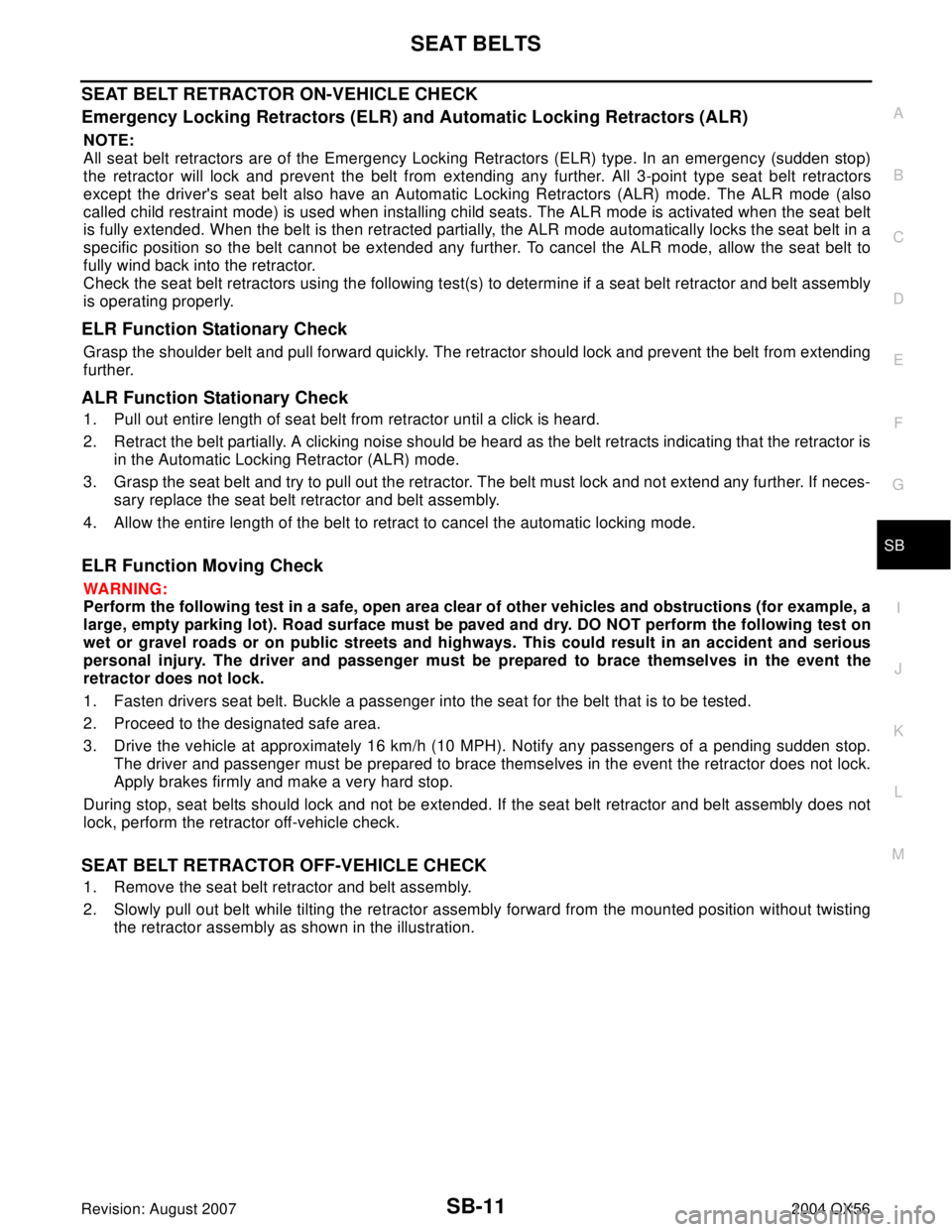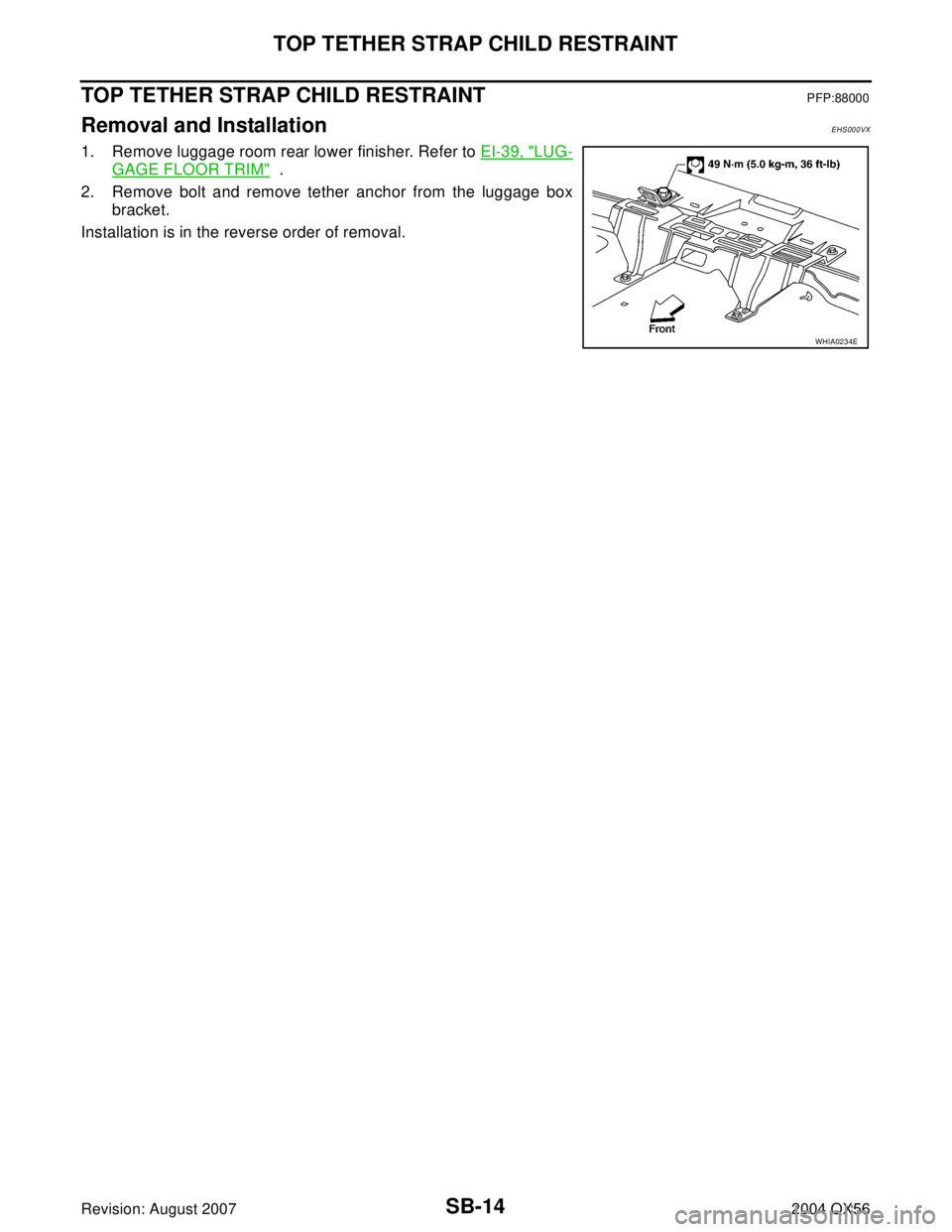2004 INFINITI QX56 child restraint
[x] Cancel search: child restraintPage 2908 of 3371

SB-1
SEAT BELTS
H RESTRAINTS
CONTENTS
C
D
E
F
G
I
J
K
L
M
SECTION SB
A
B
SB
Revision: August 20072004 QX56 PRECAUTIONS .......................................................... 2
Precautions for Supplemental Restraint System
(SRS) “AIR BAG” and “SEAT BELT PRE-TEN-
SIONER” .................................................................. 2
Precautions for Seat Belt Service ............................ 2
AFTER A COLLISION ........................................... 2
SEAT BELTS .............................................................. 3
Removal and Installation of Front Seat Belt ............. 3
REMOVAL OF SEAT BELT RETRACTOR ............ 4
INSTALLATION OF SEAT BELT RETRACTOR ..... 4
REMOVAL OF SEAT BELT BUCKLE .................... 5
INSTALLATION OF SEAT BELT BUCKLE ............ 5
Removal and Installation of Rear Seat Belt ............. 6
REMOVAL ............................................................. 6
INSTALLATION ..................................................... 7
REMOVAL OF SEAT BELT BUCKLE .................... 7
INSTALLATION OF SEAT BELT BUCKLE ............ 7
REMOVAL OF SEAT BELT RETRACTOR -
BENCH SEAT ....................................................... 7INSTALLATION OF SEAT BELT RETRACTOR -
BENCH SEAT ........................................................ 7
Third Row ................................................................. 8
REMOVAL AND INSTALLATION .......................... 8
Third Row Center ..................................................... 9
REMOVAL AND INSTALLATION .......................... 9
Seat Belt Inspection ................................................ 10
AFTER A COLLISION ......................................... 10
PRELIMINARY CHECKS .................................... 10
SEAT BELT RETRACTOR ON-VEHICLE
CHECK ................................................................ 11
SEAT BELT RETRACTOR OFF-VEHICLE
CHECK ................................................................ 11
LATCH (LOWER ANCHORS AND TETHER FOR
CHILDREN) SYSTEM ............................................... 13
Removal and Installation ........................................ 13
TOP TETHER STRAP CHILD RESTRAINT ............. 14
Removal and Installation ........................................ 14
Page 2918 of 3371

SEAT BELTS
SB-11
C
D
E
F
G
I
J
K
L
MA
B
SB
Revision: August 20072004 QX56
SEAT BELT RETRACTOR ON-VEHICLE CHECK
Emergency Locking Retractors (ELR) and Automatic Locking Retractors (ALR)
NOTE:
All seat belt retractors are of the Emergency Locking Retractors (ELR) type. In an emergency (sudden stop)
the retractor will lock and prevent the belt from extending any further. All 3-point type seat belt retractors
except the driver's seat belt also have an Automatic Locking Retractors (ALR) mode. The ALR mode (also
called child restraint mode) is used when installing child seats. The ALR mode is activated when the seat belt
is fully extended. When the belt is then retracted partially, the ALR mode automatically locks the seat belt in a
specific position so the belt cannot be extended any further. To cancel the ALR mode, allow the seat belt to
fully wind back into the retractor.
Check the seat belt retractors using the following test(s) to determine if a seat belt retractor and belt assembly
is operating properly.
ELR Function Stationary Check
Grasp the shoulder belt and pull forward quickly. The retractor should lock and prevent the belt from extending
further.
ALR Function Stationary Check
1. Pull out entire length of seat belt from retractor until a click is heard.
2. Retract the belt partially. A clicking noise should be heard as the belt retracts indicating that the retractor is
in the Automatic Locking Retractor (ALR) mode.
3. Grasp the seat belt and try to pull out the retractor. The belt must lock and not extend any further. If neces-
sary replace the seat belt retractor and belt assembly.
4. Allow the entire length of the belt to retract to cancel the automatic locking mode.
ELR Function Moving Check
WA RN ING:
Perform the following test in a safe, open area clear of other vehicles and obstructions (for example, a
large, empty parking lot). Road surface must be paved and dry. DO NOT perform the following test on
wet or gravel roads or on public streets and highways. This could result in an accident and serious
personal injury. The driver and passenger must be prepared to brace themselves in the event the
retractor does not lock.
1. Fasten drivers seat belt. Buckle a passenger into the seat for the belt that is to be tested.
2. Proceed to the designated safe area.
3. Drive the vehicle at approximately 16 km/h (10 MPH). Notify any passengers of a pending sudden stop.
The driver and passenger must be prepared to brace themselves in the event the retractor does not lock.
Apply brakes firmly and make a very hard stop.
During stop, seat belts should lock and not be extended. If the seat belt retractor and belt assembly does not
lock, perform the retractor off-vehicle check.
SEAT BELT RETRACTOR OFF-VEHICLE CHECK
1. Remove the seat belt retractor and belt assembly.
2. Slowly pull out belt while tilting the retractor assembly forward from the mounted position without twisting
the retractor assembly as shown in the illustration.
Page 2921 of 3371

SB-14
TOP TETHER STRAP CHILD RESTRAINT
Revision: August 20072004 QX56
TOP TETHER STRAP CHILD RESTRAINTPFP:88000
Removal and InstallationEHS000VX
1. Remove luggage room rear lower finisher. Refer to EI-39, "LUG-
GAGE FLOOR TRIM" .
2. Remove bolt and remove tether anchor from the luggage box
bracket.
Installation is in the reverse order of removal.
WHIA0234E
Page 3067 of 3371

SRS-6
SUPPLEMENTAL RESTRAINT SYSTEM (SRS)
Revision: August 20072004 QX56
Front Seat Belt Pre-tensioner with Load LimiterEHS000W5
The seat belt pre-tensioner system with load limiter is installed for
both the driver's seat and the front passenger's seat. It operates
simultaneously with the SRS air bag system in the event of a frontal
collision with an impact exceeding a specified level.
When the frontal collision with an impact exceeding a specified level
occurs, seat belt slack resulting from clothing or other factors is
immediately taken up by the pre-tensioner. Vehicle passengers are
securely restrained.
When passengers in a vehicle are thrown forward in a collision and
the restraining force of the seat belt exceeds a specified level, the
load limiter permits the specified extension of the seat belt by the
twisting of the ELR shaft, and a relaxation of the chest-area seat belt
web tension while maintaining force.
Front Side Air BagEHS000W6
Front side air bag modules are built into the front seatback assemblies.
Vehicles with side air bags are equipped with labels as shown.
Side Curtain Air BagEHS000W7
Side curtain air bag modules are located above the vehicle headlining.
Vehicles with side curtain air bags are equipped with labels as
shown.
Occupant Classification System EHS000W8
The occupant classification system identifies different size occupants, out of position occupants, and detects if
child seat is present in the front passenger seat. The occupant classification system receives inputs from the
occupant classification system sensor (located inside the passenger seat cushion assembly) and belt tension
sensor (part of the passenger front seat belt assembly and located at the belt anchor location). Depending on
classification of passenger, the occupant classification system sends a signal to the air bag diagnosis sensor
unit. The air bag diagnosis sensor unit uses this signal to determine deployment or non deployment of the pas-
senger front air bag in the event of a collision. Depending on the signal received, the air bag diagnosis sensor
SRS4 44
WHIA0008E
WHIA0041E